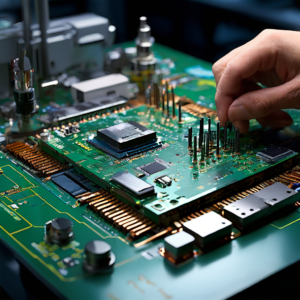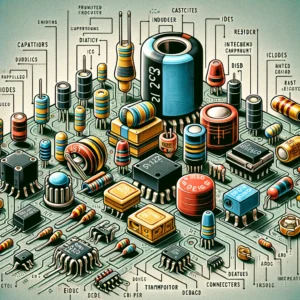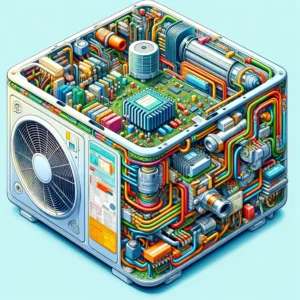10 Common Electronics Test Equipment: An Ultimate Guide
In the realm of electronics, precision and accuracy are paramount. Whether you’re a seasoned professional or a passionate hobbyist, having the right test equipment at your disposal can significantly enhance the quality and efficiency of your work.
This comprehensive guide delves into the 10 most common electronics test equipment, offering insights into their uses, benefits, and key features. From multimeters to oscilloscopes, understand how each tool can contribute to the success of your electronic projects.
1. Multimeter
A multimeter, often considered the Swiss Army knife of electronics, is essential for measuring voltage, current, and resistance. Digital multimeters (DMMs) provide precise readings and have largely replaced their analog counterparts. They are indispensable for troubleshooting and are the first tool technicians reach for when diagnosing electronic circuits.
Key Features:
- Auto-ranging capability
- Capability to measure AC/DC voltage, current, and resistance
- Continuity and diode testing
2. Oscilloscope
An oscilloscope visualizes electronic signals, offering a graphical display of their variations over time. This tool is crucial for analyzing the performance of electronic circuits, identifying problems, and verifying theories during the design and debugging phases.
Key Features:
- Bandwidth and sampling rate suitable for the application
- Digital storage and analysis capabilities
- Multiple channels for simultaneous signal comparison
3. Signal Generator
Signal generators create electronic signals of varying frequencies, amplitudes, and waveforms. They are used for testing and calibrating electronic devices, ensuring that circuits and components function correctly across a range of operating conditions.
Key Features:
- Ability to produce multiple waveforms (sine, square, etc.)
- Adjustable frequency and amplitude
- Modulation capabilities
4. Logic Analyzer
Logic analyzers are pivotal in diagnosing problems in digital circuits. They capture and display multiple signals from a digital system or digital circuit, making it easier to observe the relationship and timing between various signal lines.
Key Features:
- High channel count
- Deep memory for capturing long signal sequences
- Advanced triggering and analysis software
5. Spectrum Analyzer
Spectrum analyzers measure the magnitude of an input signal versus frequency within the full frequency range of the instrument. They are invaluable for assessing signal frequency content, identifying spurious signals, and characterizing noise in electronic circuits.
Key Features:
- Wide frequency range
- High sensitivity and resolution
- Ability to analyze both analog and digital signals
6. LCR Meter
LCR meters measure the inductance (L), capacitance (C), and resistance (R) of electronic components. These meters are vital for component inspection, quality control, and circuit design, ensuring components meet specified parameters.
Key Features:
- High accuracy and precision
- Variable test frequencies
- Detailed impedance analysis
7. Power Supply
Adjustable power supplies are crucial for providing stable and variable voltage and current to a circuit under test. They allow technicians and engineers to simulate operating conditions and test how electronic devices perform under different voltages and currents.
Key Features:
- Adjustable voltage and current settings
- Overcurrent and overvoltage protection
- Multiple outputs for simultaneous testing
8. Digital Counter
Digital counters are used to measure frequency, totalize events, or provide precise time measurements. They are essential for applications requiring high accuracy in frequency measurement or event counting.
Key Features:
- High resolution and accuracy
- Ability to measure various signal parameters
- Easy-to-read displays
9. Network Analyzer
Network analyzers are sophisticated devices used to measure network parameters in electrical networks. They are critical for characterizing the performance of components, circuits, and systems, especially in RF and microwave engineering.
Key Features:
- Measurement of S-parameters
- Wide frequency range
- Advanced calibration techniques
10. Insulation Tester
Insulation testers, or megohmmeters, measure the insulation resistance of electrical wiring and motor windings, helping prevent accidents due to insulation failure. They are crucial for maintenance in electrical installations and systems.
Key Features:
- High voltage testing capability
- Measurement of insulation resistance
- Detection of leakage currents
Conclusion
The proper use of electronics test equipment is crucial for diagnosing issues, ensuring safety, and validating the performance and reliability of electronic components and systems. This guide has provided an overview of the 10 most common pieces of electronics test equipment, each with its unique features and applications.
Whether you are a seasoned engineer or an electronics enthusiast, understanding and utilizing these tools effectively can significantly contribute to the success of your projects. Remember, the key to proficient electronics testing lies.
Share:
More Posts

Trends and Challenges in PCB Manufacturing for 2024
Trends and Challenges in PCB Manufacturing for 2024 As we move into 2024, the printed circuit board (PCB) manufacturing industry continues to evolve rapidly, driven

10 Best PCB Manufacturers in India
10 Best PCB Manufacturers in India The electronics manufacturing landscape in India has seen a significant transformation in recent years, with Printed Circuit Board (PCB)

Identifying PCB Components: A Step-by-Step Guide
Identifying PCB Components: A Step-by-Step Guide Printed Circuit Boards (PCBs) are the backbone of modern electronic devices, from simple gadgets to complex machinery. Knowing how

What is PCB in AC?
What is PCB in AC? Air conditioning has become an essential part of our daily lives, providing comfort and a conducive living environment regardless of

